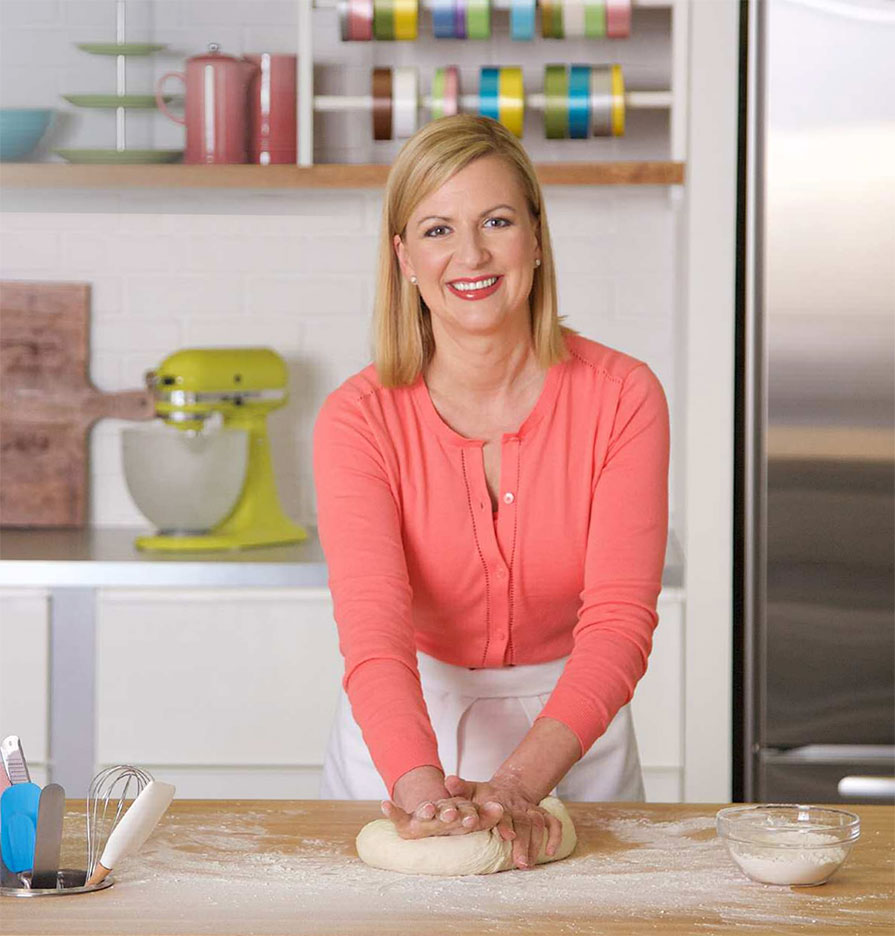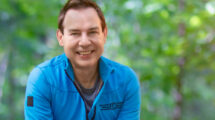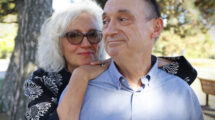By Ariel Vered and Photos by McColl
Canada’s Baking Sweetheart
How Anna Olson has made the kitchen her life’s success story.
Baking is like learning a language, says Chef Anna Olson. It’s a metaphor that she uses to describe the balance of creativity and technique that comprises the act of baking. “The ingredients are your vocabulary, technique is your grammar,” she says. “There are endless combinations of ingredients and techniques, the vocabulary and the grammar that makes every recipe a different story…
When people say, ‘how do you come up with new ideas,’ with the tools, you can constantly keep writing new stories.” Anna knows a thing or two about writing stories. The author of seven cookbooks and host of three cooking shows, the woman known as Canada’s baking sweetheart — “I prefer that title to ‘celebrity chef,’” she says — has charted a journey for herself that has taken her from the United States to Canada twice and has found her happily entrenched in Welland, Ontario, a town of 50,000, since 1995. Anna balances her successful career with a fulfilling marriage to fellow chef Michael Olson, and even mixes the two when the couple appears together at food festivals and hosts cooking seminars. “Whenever we can, we work together,” she says.
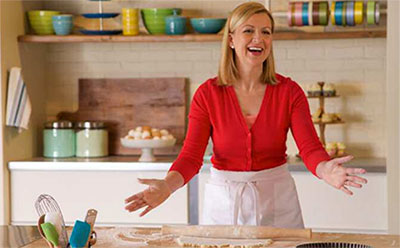 The Beginnings of Canada’s Baking Sweetheart
The Beginnings of Canada’s Baking Sweetheart
Though she’s become a Canadian culinary icon, Anna was born in Atlanta, Georgia. She was about six years old when her family moved to Canada for her father to take a graphic design professorship in York University’s fine arts department. Anna began baking at a young age. Her very first Brownie badge at the age of eight was preparing lunch (including dessert) for her family to complete her Homemaker’s Badge, while her friends were trying for their Skating Badges.
“Part of figuring out my interests as a kid, I learned early on that I am not athletically inclined,” she states. “So, while all my friends were playing after-school sports, I would go home and make cookies.”
As she grew up, baking became a recurring theme in her life, something she turned to as a stress outlet. In university, she remembers, “People in my house could always tell when essays were due or it was exam time because all of a sudden there’d be cakes and cookies lying about.” Anna credits her grandmother for having the greatest impact on her becoming a baker. “For people who love to bake, when you talk to them, there tends to be a family connection,” she says.
“Someone in the family, whether it’s mother, grandmother, aunt, or sister that you pick that up from. You learn very quickly that it’s not about just the end result. Bakers love to spend that time in the kitchen. It’s about the process, not just the finished product.”
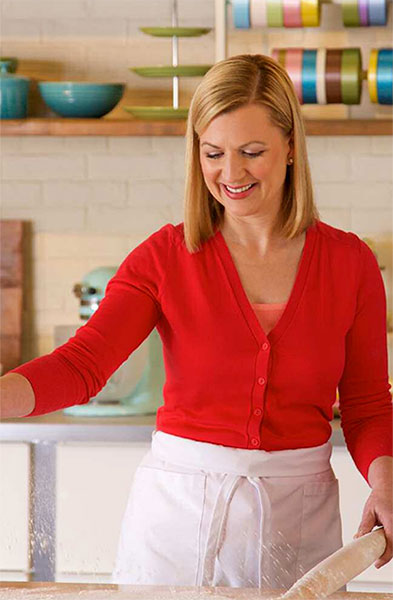 Anna’s “Muffin” Epiphany
Anna’s “Muffin” Epiphany
From her childhood in Toronto, Anna studied political science at Queen’s University and worked in currencies and bonds for a portfolio and management company. She became even more adventurous in her cooking and choice of ingredients because it was her way to de-stress. “I was taking what I learned in school in terms of research and expression and applying it to cooking because it was the one thing that was making me happy,” she says. “I was far more fulfilled doing that than working in a bank.” She had an epiphany — “I call it my muffin epiphany,” she says — when she found herself after a particularly rough day up at two a.m. making banana muffins. “It was the only thing that was going to get me to calm down and relax. In that moment, I just stared at that bowl of batter and thought,‘What on earth am I doing?’”
Recognizing that her job was making her miserable and that baking made her happy, she decided she needed to make a change. It was a bold move and she admits that it wasn’t easy telling her family that she wanted to leave a perfectly good, well-paying job in banking to become a cook’s apprentice. But she was committed to following her happiness. She searched for a program that suited her needs as a mature student who needed to hit her goals quickly and earn money while studying.
This led her to the College of Culinary Arts at Johnson & Wales University in Denver, Colorado, where she trained as a chef. After graduating, Anna worked at several restaurants in the United States. In the smaller restaurants, she would always volunteer to make desserts on the pastry chef’s days off, as needed when there was no pastry assistant on staff. “A large part of my experience was being handed a checklist and a recipe manual from the pastry chef,” she recalls.
“It was an absentee lesson. I had to figure out how to do it and do it well enough and I couldn’t leave until it was done right… That’s where my curiosity was sparked.” These ‘trial by fire’ experiences acted as a different kind of apprenticeship than the formalized ones that she had under pastry chefs. Anna has incorporated this hands-off approach to teaching into her career, albeit with less stressful stakes.
“When I try and write a recipe and teach and share now,” she says, “I feel like I’m that absentee pastry chef, where I want to give you, the home cook, as much information as I can, without being verbose, to set you up for success. So, it feels like I’m by your side but without being by your side.”
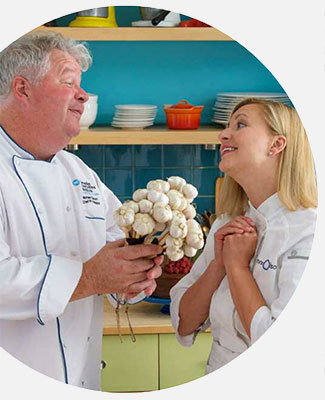 From Kitchen to Television
From Kitchen to Television
As is customary of the career trajectory of a young chef, Anna hopped around from restaurant to restaurant after completing her culinary arts degree. While working in New Orleans, she started looking around to move on to the next thing. A restaurant in Niagara called On the Twenty caught her eye for its use of local ingredients. She was hired to work on the savoury side of the restaurant. She certainly didn’t expect to meet the man who would become her husband there in the On the Twenty kitchen.
“I was enthralled with the restaurant and thought I’d stay a year so that I could see four seasons of menus,” she says. “That was 21 years ago. The restaurant drew me to Niagara and Michael kept me there.”
Anna embraced Michael’s food philosophy of “What grows together, goes together,” which he championed long before farm-to-table became a movement. “It’s a simple way to understand how to put flavours together in a way that works without even needing a recipe if you pay attention to what’s in season,” she says. The couple worked together for eight years before Michael left to teach at Niagara College.
During this time, Anna moved into pastry full-time. As she honed her skills and expanded her repertoire, the restaurant had expanded to include a banquet facility, an inn and a wedding side of the business. “My department kept growing and beautifully timed with every step of confidence,” she recalls. At the same time, Food Network Canada, newly established in 2002, was looking to generate Canadian programming.
When no one responded to an open call from the relatively unknown new network, Anna was contacted by a head hunter to apply to host a dessert show. By this point, she and Michael had published their first cookbook, The Inn on the Twenty Cookbook, so she had a little media exposure. She bristled at the idea of a television show, but then received some valuable advice from the restaurant’s general manager.
“He said to me,‘Opportunity doesn’t wait for convenience. You’ve got to jump in,’” she recalls. So, after nine years at On theTwenty, Anna entered the world of television cooking shows. While Anna never intended on becoming a TV cooking show host, she has demonstrated a remarkable ability to share her baking wisdom with her viewers through her warm personality and accessible instruction style. For her Food Network Canada audition, Anna demonstrated an apple tart.
While she recalls being disappointed with herself for not doing a more elaborate dessert, the simple nature of the dessert she chose would become the beginnings of her first show, Sugar, which premiered in 2002. Each episode featured one ingredient such as fresh ginger, creamy peanut butter, citrus zest and coconut milk. The show ran for five seasons. “You hit an endpoint within a singular concept of the show — budget, what the network wants, ratings and what your own repertoire allowed for,” she says.
This led to Fresh with Anna Olson, which showed a whole new side ofAnna to herTV audience. “I wanted to share where I lived, what I love about living in Niagara,” she says. “There is a real sense of place there.” The show, which ran for three seasons, highlighted Canadian products and cooking locally. It was an opportunity to showcase the skills she had learned training as a chef. “Most people don’t know that I did cook before I went into baking professionally,” she says.
The show has since been picked up by several countries, demonstrating what Canadian cuisine is to viewers around the world. Anna’s current show, Bake with Anna Olson, which premiered in 2012, was a return to the principles of Sugar. Surprised that no one had stepped into her shoes of producing an active instructional baking show at Food Network Canada since Sugar had ended, Anna found herself having a renewed energy of going back into baking and looking at the classics.
“Now there’s a new generation of people growing up watching the Food Network, people coming up to me saying ‘I used to watch you as a kid,’” she says. “I didn’t think I’d been around that long, but, apparently, I have! There’s a new generation of people to talk to who may have missed Sugar the first time around. And now that I have had more connection with viewers and readers in a different way than as just customers at a single restaurant, I felt like I had lots to share.”
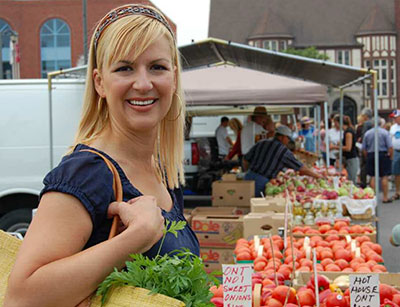 Mentoring the Next Generation
Mentoring the Next Generation
As she reflects on her career thus far and looks toward the future, Anna imparts that the most humbling thing she has learned over the years is to be prepared to fail and accept failure. “My whole journey, my task of developing recipes is about failing in order to succeed,” she says. “If I make something and it comes out okay the first time, I don’t have a lesson, I don’t have something to build on. But if I fail, there is so much to learn from that mistake.”
Resting on the laurels of her successes is not part of her DNA. Anna constantly brushes up on her skills to stay relevant and as she tests out new recipes, she donates the end of day goods to the local food bank, of which she and her husband are big supporters. As her journey up to this point has not been strategically planned, Anna says she doesn’t have a five or 10-year plan guiding her for the future.
“What is always part of the plan, is to keep learning,” she says, “to never presume that I know everything because you’d just have to quit.” Mentorship plays a very meaningful role inAnna’s professional life and it is one that she hopes to continue for years to come. Whenever she has travelled somewhere to host a seminar or appear at a food festival, she always accepts invitations to speak to students.
At primary schools, she speaks about numeracy and how math literacy in recipes is a great tool to improve basic applied math skills —“fractions and yields and temperature and measuring and geometry — and you can end with chocolate chip cookies!”
At high schools, she addresses the subjects of career development and finding your own path: “I ask them,‘What motivates you now? What makes you happy?’” She models her mentorship style on what she calls passive and loving like the one she received from her own grandmother. “If you’re baking with a family member, without saying anything you’re expressing love and being a fantastic example,” she says.
“I doubt my grandmother knew the impact she had on me just by teaching me how to breaks eggs and mix things.” Through her cookbooks and cooking shows, “I feel like I am taking on that role as a mentor,” she says.
“It’s not just teaching you how to make brownies — my goal is to instill a sense of confidence and empowerment,” she says. “If I’ve done my job right, you are happy with what you’ve done. If you bring that cake into work or that lemon meringue pie or that birthday cake for a granddaughter and it came from my recipe and you feel good about it?Then my work is done.”
And, what if her recipes become incorporated into the baking fabric of her readers and viewers? That is icing on the cake. “If my recipes are worked into the repertoire that grandmothers are making with their grandkids and it becomes part of a tradition or ritual for them,” Anna says, “then that’s what I would be happy with.”



